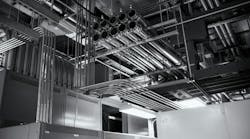The weak global economy over the past two years has created a perfect storm of business challenges for electrical contracting firms, particularly those relying heavily on new construction. Credit and bonding constraints have led to tighter lending practices by banks, postponing or canceling many commercial building projects. New residential construction has all but dried up in most areas of the United States. In addition, many state and local governments are facing sizable budget gaps, hindering opportunities in that market.
In other words, there is increased competition for a smaller pool of available new construction work today than ever before. Although many electrical contractors have had no choice but to look for work in markets they haven't traditionally served simply to keep their workforce busy, the most astute are approaching the current conditions with an eye on the potential — as opposed to the problem. In short, they are actively investigating emerging trends that will not only allow their business to survive today's challenges, but also thrive tomorrow.
One of those emerging trends is energy management, which can mean various things to end customers. For some, it simply means replacing inefficient appliances with Energy Star-rated counterparts or commissioning an energy audit. For others, it means efficient control and monitoring of electrical use. No matter what approach the customer chooses, however, drivers as diverse as federal energy-efficiency regulations, green building certification programs, and concerns about energy cost increases are making energy an issue that is prompting more action.
This presents a unique opportunity for electrical contractors to diversify their offering and become an energy management service provider (Four Steps of a Strategic Energy Management Plan on page 19). This could include promoting services such as formulating a strategic energy management plan, leading energy audits, recommending technology solutions, performing installations, and documenting savings. It also provides immense potential for repeat business — perhaps years or even decades into the future — as customers' needs change. In short, diversification can help guide energy management actions so customers achieve the maximum energy and cost savings.
Multiple drivers
New construction is bound by the requirements of the energy code adopted by the state or municipality in which a building or home is located, which can vary greatly. For a comprehensive look at the status of commercial and residential energy codes by state, see http://www.energycodes.gov/implement/state_codes/index.stm. Some energy codes, such as California's Title 24, are state-developed, which take into account state-specific concerns such as climate. Other states adopt specific amendments to nationally recognized codes, such as ANSI/ASHRAE/IESNA Standard 90.1 or the International Energy Conservation Code (IECC).
While it's crucial for all electrical contractors to understand their state's energy code, those who diversify their offering to include energy management services must understand the various energy-efficiency drivers for owners and managers of existing buildings. Some of those drivers include:
-
Rising electricity costs: According to the U.S. Department of Energy's Energy Information Administration, the per-kilowatt hour cost of electricity rose from 7.6 cents to 9.8 cents from 2004 to 2008 — a 28.8% increase. That amount is expected to increase to 10.7 cents by 2010, another 9.2% jump, meaning the cost of electricity will have jumped nearly 41% from 2004 to 2010.
-
Federal regulations: When the customer is the United States government, requirements of federal energy legislation are paramount. For example, the Energy Independence and Security Act of 2007 requires all federal government facilities to reduce energy consumption by 3% per year through 2015 for a total 30% reduction. The Energy Policy Act of 2005 (EPAct 2005) requires facility managers to develop a metering plan for their building and install advanced electric meters by Oct. 1, 2012.
-
Green building certification programs: Programs like the Leadership in Energy & Environmental Design (LEED) Green Building Rating System, administered by the U.S. Green Building Council (USGBC), are growing in prominence. LEED is a leading-edge system for designing, constructing, operating, and certifying the greenest, most environmentally friendly buildings. LEED certification is achieved by meeting various prerequisites and accruing supplemental credit points in several areas. Many customers who own or operate commercial buildings have realized the marketplace advantages that can be gained by LEED certification, not to mention the energy and cost savings benefits.
-
The Smart Grid: Though in its infancy, the Smart Grid concept is essentially a much more automated electrical power grid that allows for integration of new technologies that might further the efficiency of producing and distributing energy. For example, the Smart Grid will employ a set of technologies to allow customers to adjust their electrical consumption automatically based on fluctuations in electricity availability or rates. It will also provide the ability to access important data about performance, demand, and availability.
-
Renewable energy sources: Gone are the days when the local neighborhood tinkerer owned the only home for miles around with a photovoltaic (PV) array. More homeowners are realizing that harnessing the sun's rays can have a profound effect on their monthly electric bill. But other renewable energy sources, such as wind power, are also coming to the fore, requiring contractors who possess the ability to make that energy work for their customers.
-
Residential energy management: Home energy management used to mean lowering the thermostat or air-conditioning. But residential energy metering, similar to that done in commercial buildings, is on the horizon. Additionally, communication gateways are available that measure the amount of power a PV system is generating, along with calculating both energy and greenhouse gas savings.
Energy efficiency vs. management
The drivers above indicate that achieving improved energy efficiency is on the minds of virtually all customers electrical contractors serve. However, a distinction must be drawn between energy efficiency, which is the desired end result, and energy management, or a strategic action plan designed specifically to achieve that result. This is where the core of a contractor's diversification opportunity lies for electrical contractors:
-
Contractors already possess vast equipment installation expertise. In fact, most have a strong sense of the technology solutions that will translate to both energy management and increased energy efficiency.
-
Because contractors are not affiliated with a utility (and thus do not sell electricity), they can advocate for the best interests of customers and their energy-efficiency goals.
-
Contractors also have the experience of working with diverse products and applications, so they can craft the most optimal solution for a given application.
Because energy management is a rapidly evolving marketplace, new products and technologies are constantly being introduced that can decrease costs, meet energy-efficiency mandates, or help gain green certification. Staying on top of such advancements can be a challenge — almost as challenging as keeping abreast of the key market drivers mentioned previously. But as with anything, contractors who proactively bolster their knowledge in both areas will be best positioned to diversify their offering to include energy management services.
Taking the time to acquire that knowledge is particularly important. While the current economic slowdown might be disconcerting for some contractors, it may be the perfect window of opportunity for such a venture.
Making the choice
Although some electrical contractors may be hesitant to diversify their offering toward energy management services due to lack of time or man power, it's important to stay informed about energy-related marketplace trends. The reason is simple: While contractors might not be trying to generate new business in this area, marketplace changes will likely prompt questions from existing or new customers. That means that simply by default, a contractor may be called upon to be his or her area's energy management consultant. Being prepared for that possibility is prudent as well as vital for survival.
Golden is a market segment manager — electrical contractors with the North American Operating Division of Schneider Electric, Nashville. She can be reached at [email protected].
Sidebar: Four Steps of a Strategic Energy Management Plan
While there are many ways to instantly improve an existing commercial building's efficiency by varying degrees, the overall goal should be continuous improvement. Carefully constructed, a strategic energy management plan that incorporates a keen understanding of the customer's energy-efficiency goals — including budgetary parameters and payback threshold, along with the appropriate product solutions and technologies — will foster a mind-set of ongoing energy planning and accountability. The most effective plans comprise four basic steps:
Step 1: Measure energy usage.
The first step entails collecting data from major energy consumers and analyzing the impact of those consumers on total consumption. For example, installing power metering and monitoring in a commercial building is crucial to establishing an energy usage baseline.
Step 2: Fix the basics.
Fixing the basics typically consists of efforts, such as installing low-energy-consumption devices or improving a building's power factor. Although they can translate to substantial savings, such measures are typically a one-time improvement — or a passive approach to energy management. For example, because a new energy-efficient transformer has a useful life cycle of two decades or more, its overall energy-efficiency impact is limited.
Step 3: Automate where appropriate.
Ongoing energy-efficiency improvements can be achieved by automating and regulating building systems. Measures such as schedule-based lighting control and occupancy sensors automatically turn lights on only when they are needed in commercial buildings, while HVAC control regulates heating and cooling at optimal levels, which can change from day to day.
More importantly, however, these measures facilitate an active approach to energy management, because they can be adjusted based on new energy-efficiency opportunities that arise in the future. One recent example is demand response, where preselected electrical loads are turned off based on an electric utility request or when electrical rates meet a preset threshold.
Step 4: Monitor and control.
A strategic energy management plan also helps ensure that initial energy and cost savings don't erode over time. Power meter installations, monitoring services, energy-efficiency analysis, energy bill verification, and implementation of an enterprise energy management (EEM) system can all help achieve this end.




